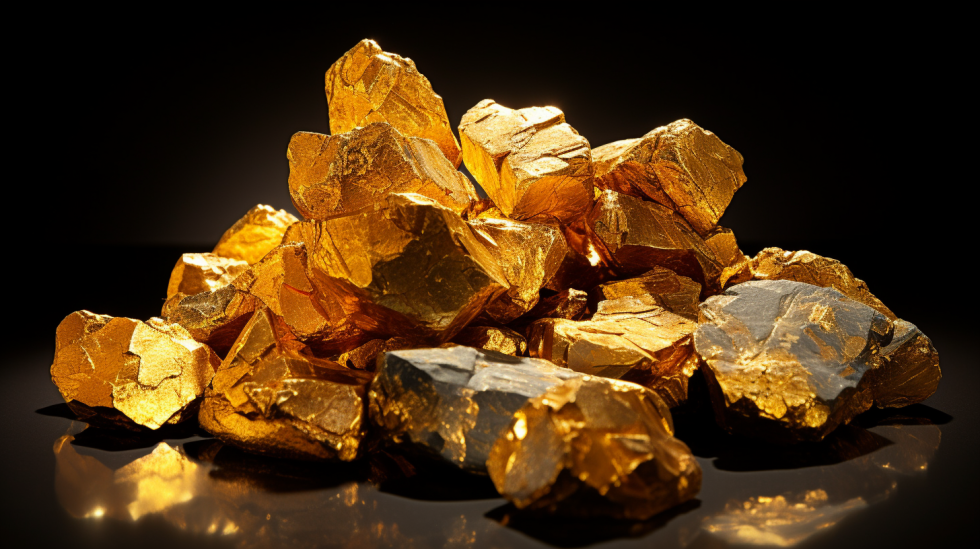Gold, coveted for its radiant beauty and enduring value, is often associated with gleaming coins, ornate jewelry, and refined bars. Yet, there exists a more primal and captivating form of gold—the natural gold nugget. These nuggets, often discovered in streams, riverbeds, and the depths of the Earth, are the result of millions of years of geological processes. In this exploration of natural gold nuggets, we’ll uncover the allure, formation, discovery, and significance of these unaltered treasures of the Earth.

The Allure of Natural Gold Nuggets
Natural gold nuggets possess a mystique and allure that sets them apart from their refined counterparts. They captivate the imagination and evoke a sense of wonder for several reasons:
1. Unadulterated Beauty
Natural gold nuggets showcase gold in its raw and unaltered state. They exhibit a unique blend of colors, from the bright, shining yellow of pure gold to the subtle hues of copper or silver that may be present due to mineral impurities. Each nugget is a one-of-a-kind work of art created by nature.
2. Geological Time Capsules
Gold nuggets provide a glimpse into Earth’s geological history. They are tangible remnants of processes that unfolded over millions of years, from the formation of gold deep within the Earth to its journey to the surface through geological events.
3. Rarity and Authenticity
Natural gold nuggets are exceedingly rare. They represent a tiny fraction of the world’s gold production, making them highly sought-after by collectors and investors. Their authenticity and unaltered nature add to their appeal.
4. Connection to Prospectors of the Past
Gold nuggets harken back to the days of the great gold rushes, when prospectors ventured into untamed wilderness in pursuit of fortune. These nuggets are a link to the pioneers and adventurers of the past.
The Formation of Natural Gold Nuggets
The formation of natural gold nuggets is a complex and fascinating geological journey that begins deep within the Earth. Here’s a step-by-step exploration of how these nuggets come into existence:
1. Genesis in the Earth’s Crust
Gold is initially formed within the Earth’s crust through various geological processes. It is typically found in quartz veins or as disseminations in other rocks.
2. Concentration Through Hydrothermal Activity
Hydrothermal activity plays a crucial role in concentrating gold into more significant deposits. Hot, mineral-rich fluids rise from the Earth’s mantle and migrate into the crust. These fluids can dissolve gold and other minerals, carrying them upwards.
3. Deposition in Quartz Veins
As the hydrothermal fluids cool and pressure decreases, they can no longer hold the dissolved minerals. This leads to the precipitation of gold and other minerals within quartz veins. Gold can form as sheets, wires, or even crystalline structures within these veins.
4. Erosion and Transport
Over millions of years, geological processes like weathering and erosion wear away the Earth’s surface, exposing gold-bearing quartz veins. As these veins are eroded, gold particles are released and transported by rivers and streams.
5. Riverbed Dynamics
Gold particles, now free from their quartz host, are carried downstream by the flow of water. They are subject to the forces of gravity and hydraulic sorting, which can lead to the formation of natural gold nuggets.
6. Nuggets Take Shape
As gold particles are transported, they may collide with one another, and the flowing water can shape them into rounded nuggets. The size, shape, and purity of these nuggets depend on the specific geological conditions and the distance they travel.
Discovering Natural Gold Nuggets
Discovering natural gold nuggets is a pursuit that has drawn prospectors, treasure hunters, and adventurers for centuries. The thrill of stumbling upon one of these treasures in the wild is a dream shared by many. Here are some key aspects of finding natural gold nuggets:
1. Location, Location, Location
The location is paramount when searching for natural gold nuggets. Prospectors often target areas with a history of gold production, such as old mining districts, known gold-bearing rivers, or regions with geological features conducive to gold deposition.
2. Tools of the Trade
Prospectors use various tools and equipment to aid in their search for gold nuggets. These can include metal detectors, gold pans, sluice boxes, and even small dredges for underwater prospecting.
3. Geological Knowledge
Understanding the geology of an area is essential. Prospectors learn to recognize geological indicators that suggest the presence of gold, such as quartz veins, iron deposits, and other associated minerals.
4. Patience and Persistence
Prospecting for gold nuggets is not a guaranteed endeavor. It requires patience and persistence, as success often comes after countless hours of searching, sifting through gravel, and following leads.
5. Ethics and Regulations
Responsible prospecting adheres to ethical guidelines and complies with local regulations. Many areas have specific rules regarding prospecting, and it’s crucial to respect the environment and other land users.
Natural Gold Nuggets: From Discovery to Collection
The moment of discovery is just the beginning of a gold nugget’s journey. Here’s what happens after a nugget is found:
1. Identification and Assessment
Upon finding a potential nugget, prospectors carefully inspect it to confirm its authenticity and assess its size, shape, and purity. They may use scales and magnifying glasses to evaluate its quality.
2. Documentation
Serious collectors and prospectors often document the find, recording details such as the location, date, and circumstances of the discovery. This documentation can enhance the nugget’s historical and collector value.
3. Cleaning and Preservation
Natural gold nuggets are typically cleaned to remove any dirt or debris. This process can involve soaking the nugget in warm soapy water and gently scrubbing it with a soft brush.
4. Display and Storage
Gold nuggets can be displayed in various ways, depending on their size and value. Some nuggets are kept as collector’s items and are mounted in jewelry or display cases. Others are stored in secure vaults or safe deposit boxes.
5. Valuation and Sale
The value of a natural gold nugget is influenced by factors such as its size, purity, shape, and rarity. Nuggets can be sold to collectors, investors, or dealers specializing in gold specimens.
6. Ethical Considerations
Ethical considerations are essential when collecting or selling natural gold nuggets. Responsible collectors adhere to ethical sourcing practices and avoid acquiring nuggets that may have been obtained through environmentally harmful or illegal means.
The Significance of Natural Gold Nuggets
Natural gold nuggets hold significance beyond their aesthetic and monetary value. They provide valuable insights into Earth’s geological history, the dynamics of river systems, and the allure of the hunt. Here are some additional aspects of their significance:
1. Geological Education
Natural gold nuggets are valuable educational tools. They can be used to teach geology and mineralogy, illustrating concepts such as mineral formation, crystallization, and erosion.
2. Historical Connection
Gold rushes and prospecting have played a significant role in the history of many regions. Natural gold nuggets serve as tangible links to this period of exploration and economic development, connecting the present to the past.
3. Cultural Significance
Gold has cultural significance in many societies around the world. Natural gold nuggets often feature in indigenous myths, legends, and art, underscoring their cultural importance.
4. Scientific Research
Gold nuggets can be subjects of scientific research, providing valuable data on the Earth’s geological processes, the movement of minerals in river systems, and the formation of gold deposits.
5. Collector’s Treasures
For collectors, natural gold nuggets represent a unique and tangible connection to the natural world. Their rarity and beauty make them highly prized items, both for private collections and public displays in museums.
6. Symbol of Exploration
Natural gold nuggets symbolize the spirit of exploration and adventure. They are a reminder of the daring individuals who once trekked into untamed wilderness in pursuit of fortune.
Ethical Considerations and Conservation
The pursuit of natural gold nuggets, like any form of resource extraction, must be approached with ethical considerations and environmental conservation in mind. Here are some key points to keep in mind:
1. Environmental Impact
Prospecting and mining activities can have environmental impacts, particularly when conducted irresponsibly. Erosion, habitat disruption, and water pollution are concerns that must be addressed through responsible practices.
2. Ethical Sourcing
Collectors and buyers of natural gold nuggets should ensure that their acquisitions are ethically sourced. Nuggets obtained through environmentally harmful or illegal means should be avoided.
3. Conservation of Natural Areas
Prospectors and collectors should respect protected natural areas and wildlife habitats. Responsible practices include adhering to regulations, minimizing disturbances, and practicing Leave No Trace principles.
4. Ethical Trade
When buying or selling natural gold nuggets, it’s important to engage in ethical trade practices. This includes transparent transactions, fair pricing, and compliance with legal requirements.
5. Supporting Conservation Efforts
Those involved in gold prospecting or collection can contribute to conservation efforts by supporting organizations and initiatives dedicated to preserving natural environments and ecosystems.
Conclusion: Nature’s Golden Artistry
Natural gold nuggets are more than just geological curiosities; they are nature’s golden artistry, shaped by the Earth’s processes over eons. Their allure lies in their unaltered beauty, their connection to the past, and their role as symbols of exploration and adventure.
While the pursuit of natural gold nuggets continues to captivate prospectors and collectors, it is essential that this pursuit is conducted with a commitment to responsible practices, ethical sourcing, and environmental conservation. This ensures that these treasures of the Earth can continue to be enjoyed and appreciated for generations to come.
As we marvel at the beauty and rarity of natural gold nuggets, let us also reflect on the broader lessons they offer—the enduring allure of the natural world, the importance of responsible stewardship, and the appreciation of Earth’s geological history as told through these shimmering, unaltered treasures.



